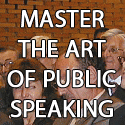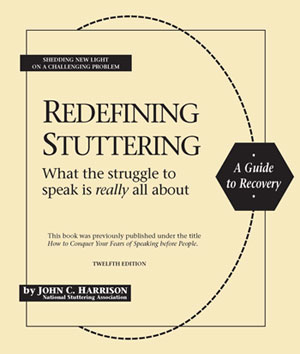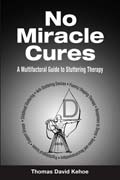In my last couple of posts, I have spoken about the psychological side of stuttering/stammering, and how our fear of speaking anxiety, is largely as a result of the perceived consequence of speaking with dysfluent speech. I spoke about some of the typical destructive and fear of speaking anxiety provoking consequences, that we can conjure up in our mind. This type of thinking has been referred to by some as “stinking thinking”.
 Thinking this way is not resourceful to us. It is guaranteed to make us stutter worse, because of the consequence that we place on being dysfluent, in these situations. For example, “if I stutter in this job interview I will definitely not get the job because everyone hates stuttering people”. If you layer that with further negative thinking like, “ if I cannot get a job I will have no income”, and then continue to add to that further layers like, “if I have no income I might become homeless”, “if I am homeless I may not have any food”, “if I have no food I will die”. Now obviously we are not conscious of layering these thoughts onto thoughts, but we certainly do it subconsciously, and in a fraction of a second. If we do not recognise, and accept, that many of our fears, subconsciously layer themselves back to the “fear of death”, we will not understand why there is such fear and anxiety, associated with having some trouble in getting words out of our mouth, and into the other person’s head. We are born with an innate belief, which is often confirmed through our childhood experiences, that those who are “obviously flawed” in some way, are often singled out and marginalised, or “sacrificed” in some way by the group. So there is a deep fear there within every human being, of being seen to be “different” when we know we are otherwise. Such thoughts, if allowed to run rampant in your head, can lead to panic attacks, or at the least, a constant high level of anxiety, and can totally control the direction in which your life progresses. Can all fear be traced back to the fear of death? At the deepest layered level “YES”. This is a key understanding that you must have, if you are to alter your innate and reflex thinking, about situations where you are allowing the consequence of your dysfluent speech, to determine your anxiety level. You must learn to intervene at the base thought, so that increasingly toxic thoughts, do not escalate the consequences of dysfluent speech to the point where they send your speech spiralling out of control and into uncontrolled avoidance, shame, embarrassment and panic, which ultimately leads to ever increasing levels of stuttering.
Thinking this way is not resourceful to us. It is guaranteed to make us stutter worse, because of the consequence that we place on being dysfluent, in these situations. For example, “if I stutter in this job interview I will definitely not get the job because everyone hates stuttering people”. If you layer that with further negative thinking like, “ if I cannot get a job I will have no income”, and then continue to add to that further layers like, “if I have no income I might become homeless”, “if I am homeless I may not have any food”, “if I have no food I will die”. Now obviously we are not conscious of layering these thoughts onto thoughts, but we certainly do it subconsciously, and in a fraction of a second. If we do not recognise, and accept, that many of our fears, subconsciously layer themselves back to the “fear of death”, we will not understand why there is such fear and anxiety, associated with having some trouble in getting words out of our mouth, and into the other person’s head. We are born with an innate belief, which is often confirmed through our childhood experiences, that those who are “obviously flawed” in some way, are often singled out and marginalised, or “sacrificed” in some way by the group. So there is a deep fear there within every human being, of being seen to be “different” when we know we are otherwise. Such thoughts, if allowed to run rampant in your head, can lead to panic attacks, or at the least, a constant high level of anxiety, and can totally control the direction in which your life progresses. Can all fear be traced back to the fear of death? At the deepest layered level “YES”. This is a key understanding that you must have, if you are to alter your innate and reflex thinking, about situations where you are allowing the consequence of your dysfluent speech, to determine your anxiety level. You must learn to intervene at the base thought, so that increasingly toxic thoughts, do not escalate the consequences of dysfluent speech to the point where they send your speech spiralling out of control and into uncontrolled avoidance, shame, embarrassment and panic, which ultimately leads to ever increasing levels of stuttering.
If we accept that creating negative consequences, of dysfluent speech, are leading to higher anxiety, and that these consequences, are as a result of our own thoughts and feelings, and that we can change these thoughts and feelings, then we can start to look for ways to make these changes.
So how can this be achieved? There are various methods that have been, and are used, to train people, not only people who stutter, to look at the validity of their thoughts and feelings.
The first of these is a process known as Cognitive Behaviour Therapy, also know as CBT. CBT teaches the individual to look into and analyse the negative thoughts, and the negative consequences, that they see a particular action will have, and look for the real validity in those perceptions. Ideally the CBT practitioner helps the individual to see that there is no validity in the analysed perception and that the thoughts were in fact illogical to varying degrees and lack substantiation. In this case the thoughts revolve around stuttering. For instance if the individual may have the perception that if he blocks and stutters, the listener will think he is “retarded in some way”, or, “of lesser intelligence”, or, “not telling the truth”, (see the list of general consequences in my last post). Closer analysis of these thoughts are aimed at revealing that there is no evidence to support them as truth. By getting the person who stutters, to see how unfounded or illogical these thoughts are, by constantly asking what evidence they have for these perceptions, one can learn to replace these thoughts with more logical, and more personally useful thoughts, and so lower the speaking anxiety level.
The second and less known process, is known as Neuro-Semantics, which is an offshoot of a process known as Neuro Linguistic Programming, also known as NLP. This method works on the premise, that if you can speak fluently in any particular situation, you can learn to speak fluently in all situations. To do this, you need to learn to identify the “state of mind” that you are in when you are fluent, and the different states that you are in when you are blocking and stuttering, and then learn to step into that fluent state of mind, at will. It works on the premise that stuttering is a “thinking problem”, that manifests in a “speaking problem”. Neuro-semantics seeks to change the meanings that you have given to certain events, in your life experiences, from being fear based to being more resourceful to you. The premise is that blocking and stuttering is panic and anxiety expressing itself in the muscles that control speech. Just like a panic attack, a speech block is triggered psychologically. This work has been pioneered by Dr Bob Bodenhamer, in consultation with Michael Hall, both master practitioners in NLP and Neuro-Semantics. The theory and practice involved in mastering these methods of reducing speaking anxiety, are not simple to understand and put into practice, so guidance from a master practitioner in this method is advisable, but hard to find. Thankfully Dr Bodenhamer, has published a book on how to understand and apply this process, which for the cost of a weeks supply of Pagoclone, would be a very worth addition to your “toolkit” to attack speaking anxiety and stuttering. The book is called, “Mastering Blocking and Stuttering”. I personally believe that Neuro-Semantics starts off where CBT leaves off and is a more powerful process.
There are other methods of addressing the psychological side of the personality, that has developed wrapped in the “vines of stuttering”, and one of those is Personal Construct Therapy, also know as Narrative Therapy. In simple terms, that method looks at the way that the person, has constructed their whole persona as a person who stutters, and endeavours to address the difficulties that the person faces in developing the persona of a fluent or more fluent speaker.
Other methods include visualisation, meditation and modalities that seek to remove the emotions and trauma trapped in the energy fields of the body, as a result of stuttering experiences and other personally disturbing experiences, that contribute to your reflex fear and anxiety levels. These methods include such emerging modalities as, “pranic healing”, and, “emotional freedom therapy”, also known as EFT. But once again, these are all topics for coming posts, so I again urge you to subscribe to my RSS feed or email notification, so that you do not miss posts about subjects and content that you will not read anywhere else. If you found this post thought provoking in any way, please make a comment.
Comments:








{ 4 comments… read them below or add one }
Jack
Indeed I found this post thought provoking. I have wondered many a time at how I am fluent and eloquent in my comfort zone, (between fellow graduates of the McGuire Programme), but suffer from turbulence when presenting a case in court.
I am however of the opinion that the single greatest fear stutterers have, is the fear of stuttering. The mindset change that needs to happen is to accept oneself as a stutterer. Once this is fully achieved, there is no fear of stuttering. Why else does you stuttering level drop after having been deliberately disfluent in a conversation, thereby indicating to your listener that you are indeed a stutterer, and so what?
I am in the process of self-acceptance, it really does take time and effort.
I shall be visiting your site regularly to read new updates 🙂
Hey Jack, thanks for the friend request. Good article(s); I was pleasantly surprised to read the section on Neuro-Semantics, because that's the process that I have been doing on my own for a while now. In my experience it's very effective (certainly more effective than speech therapy seemed to be). Where can I read up on the theories behind the causes for stuttering and such?
I'm a school speech pathologist. Your comment are very good and very helpful. I am particularly hoping for some comments on DAF (especially Casa Futura). Thank you for doing this blog.
I now understand the meaning of NLP.
Thank you.